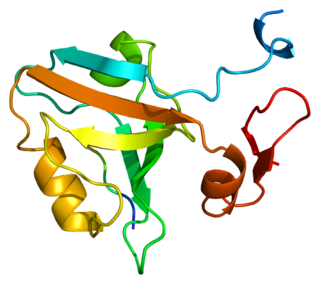Na(+)/H(+) exchange regulatory cofactor NHE-RF3 is a protein that in humans is encoded by the PDZK1 gene. [5] [6]
Na(+)/H(+) exchange regulatory cofactor NHE-RF3 is a protein that in humans is encoded by the PDZK1 gene. [5] [6]
PDZK1 has been shown to interact with:
The sodium/phosphate cotransporter is a member of the phosphate:Na+ symporter (PNaS) family within the TOG Superfamily of transport proteins as specified in the Transporter Classification Database (TCDB).

Erbb2 interacting protein (ERBB2IP), also known as erbin, is a protein which in humans is encoded by the ERBB2IP gene. Discovered in 1997, erbin is a 200kDa protein containing a PDZ domain.

Neutral and basic amino acid transport protein rBAT is a protein that in humans is encoded by the SLC3A1 gene.

PSD-95 also known as SAP-90 is a protein that in humans is encoded by the DLG4 gene.

Sodium-hydrogen antiporter 3 regulator 1 is a regulator of Sodium-hydrogen antiporter 3. It is encoded by the gene SLC9A3R1. It is also known as ERM Binding Protein 50 (EBP50) or Na+/H+ Exchanger Regulatory Factor (NHERF1). It is believed to interact via long-range allostery, involving significant protein dynamics.

Sodium-hydrogen exchange regulatory cofactor NHE-RF2 (NHERF-2) also known as tyrosine kinase activator protein 1 (TKA-1) or SRY-interacting protein 1 (SIP-1) is a protein that in humans is encoded by the SLC9A3R2 gene.

Multidrug resistance-associated protein 2 (MRP2) also called canalicular multispecific organic anion transporter 1 (cMOAT) or ATP-binding cassette sub-family C member 2 (ABCC2) is a protein that in humans is encoded by the ABCC2 gene.

GIPC PDZ domain containing family, member 1 (GIPC1) is a protein that in humans is encoded by the GIPC1 gene. GIPC was originally identified as it binds specifically to the C terminus of RGS-GAIP, a protein involved in the regulation of G protein signaling. GIPC is an acronym for "GAIP Interacting Protein C-terminus". RGS proteins are "Regulators of G protein Signaling" and RGS-GAIP is a "GTPase Activator protein for Gαi/Gαq", which are two major subtypes of Gα proteins. The human GIPC1 molecule is 333 amino acids or about 36 kDa in molecular size and consists of a central PDZ domain, a compact protein module which mediates specific protein-protein interactions. The RGS-GAIP protein interacts with this domain and many other proteins interact here or at other parts of the GIPC1 molecule. As a result, GIPC1 was independently discovered by several other groups and has a variety of alternate names, including synectin, C19orf3, RGS19IP1 and others. The GIPC1 gene family in mammals consisting of three members, so the first discovered, originally named GIPC, is now generally called GIPC1, with the other two being named GIPC2 and GIPC3. The three human proteins are about 60% identical in protein sequence. GIPC1 has been shown to interact with a variety of other receptor and cytoskeletal proteins including the GLUT1 receptor, ACTN1, KIF1B, MYO6, PLEKHG5, SDC4/syndecan-4, SEMA4C/semaphorin-4 and HTLV-I Tax. The general function of GIPC family proteins therefore appears to be mediating specific interactions between proteins involved in G protein signaling and membrane translocation.

Solute carrier family 22, member 4, also known as SLC22A4, is a human gene; the encoded protein is known as the ergothioneine transporter.

Golgi-associated PDZ and coiled-coil motif-containing protein is a protein that in humans is encoded by the GOPC gene.

H+/Cl− exchange transporter 3 is a protein that in humans is encoded by the CLCN3 gene.

Microtubule-associated serine/threonine-protein kinase 2 is an enzyme that in humans is encoded by the MAST2 gene. The protein encoded by this gene controls TRAF6 and NF-kappaB activity.

Regulator of G-protein signaling 12 is a protein that in humans is encoded by the RGS12 gene.

A kinase anchor protein 10, mitochondrial is an enzyme that in humans is encoded by the AKAP10 gene.

Solute carrier family 22, member 12, also known as SLC22A12 and URAT1, is a protein which in humans is encoded by the SLC22A12 gene.

STE20-like serine/threonine-protein kinase is an enzyme that in humans is encoded by the SLK gene.

PDZK1-interacting protein 1 is a protein that in humans is encoded by the PDZK1IP1 gene.

Sodium-dependent phosphate transport protein 1 is a protein that in humans is encoded by the SLC17A1 gene.

FERM, RhoGEF and pleckstrin domain-containing protein 2 is a protein that in humans is encoded by the FARP2 gene.

Sodium-dependent phosphate transport protein 2C is a protein that in humans is encoded by the SLC34A3 gene.